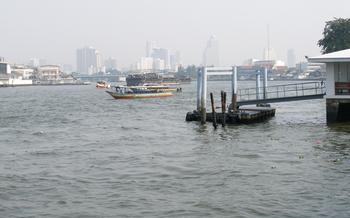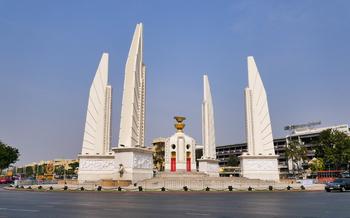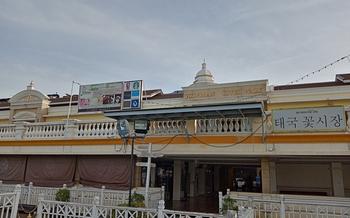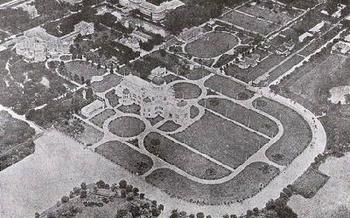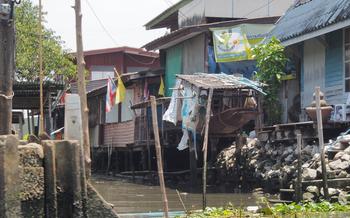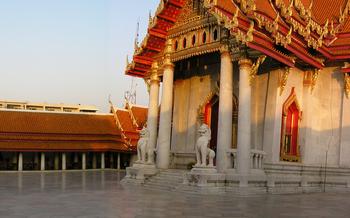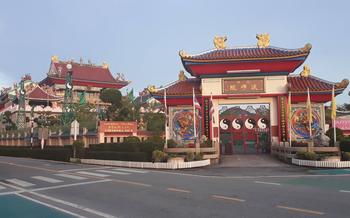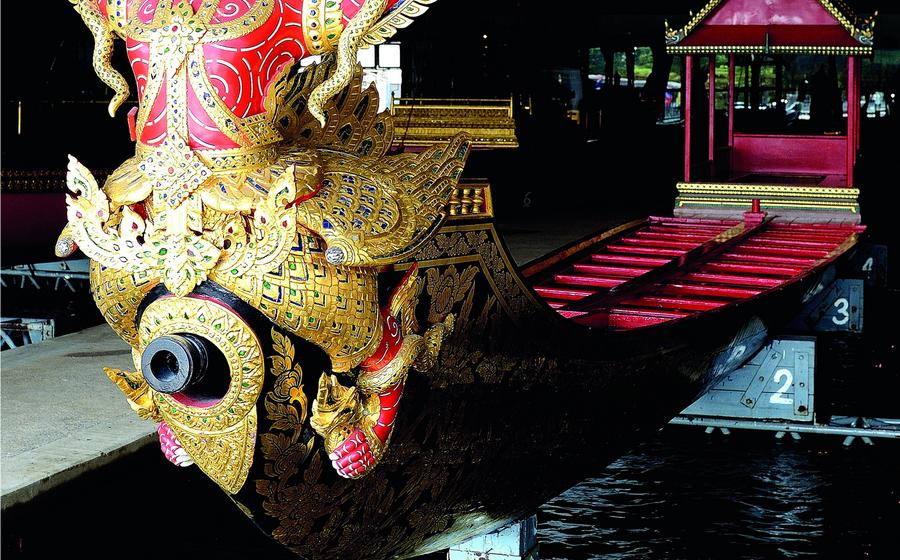
Royal Barge National Museum
- Historical Significance
- Types of Royal Barges
- Construction and Materials
- Royal Barge Procession: A Spectacle of History and Tradition
- Restoration and Preservation
- Exhibits and Displays
- Guided Tours
- Photography and Videography
- Souvenirs and Merchandise
- Accessibility and Facilities
- Ticket Prices and Hours of Operation
- Location and Transportation
- Nearby Attractions
- Insider Tip: Unveiling the Secret Royal Barge
Historical Significance
The Royal Barge National Museum is a treasure trove of Thai history and culture, preserving the grandeur of the royal barges that played a pivotal role in Thailand's past. These magnificent vessels were not mere modes of transportation but symbols of royalty, power, and prestige, used in grand ceremonies, processions, and royal coronations. The museum offers a fascinating glimpse into this rich heritage, showcasing the intricate craftsmanship, artistry, and cultural significance of these remarkable vessels.
The history of the royal barges dates back to the Ayutthaya Kingdom, when they were used for both ceremonial and practical purposes. The barges were essential for transporting the king and his entourage during royal processions along the Chao Phraya River, which served as the kingdom's main waterway. They also played a crucial role in naval warfare, transporting troops and supplies during battles.
Over the centuries, the royal barges evolved into elaborate works of art, adorned with intricate carvings, gilded ornaments, and colorful decorations. Each barge had a unique design and purpose, reflecting the status and authority of its royal owner. The museum's collection includes a diverse array of these barges, from the grand ceremonial barges used in royal coronations to the smaller pleasure barges used for leisure and entertainment.
Types of Royal Barges
The Royal Barge National Museum houses an impressive collection of diverse royal barges, each serving a specific purpose in Thai history and culture. These vessels range from ceremonial barges used in grand processions to war barges that played a crucial role in naval battles.
Ceremonial Barges: These intricately designed barges are the epitome of elegance and grandeur. Used in royal ceremonies and religious festivals, they feature elaborate carvings, gilded ornaments, and colorful fabrics. Their majestic presence adds a touch of splendor to these auspicious occasions.
War Barges: Built for combat on the water, war barges were equipped with cannons and other weapons. Their sturdy construction and formidable appearance served as a symbol of the kingdom's military might. These barges played a vital role in defending Thailand's sovereignty during times of conflict.
Pleasure Barges: Designed for leisure and entertainment, pleasure barges were used by the royal family for excursions and recreational activities. These barges offered a luxurious and serene setting for relaxation and enjoyment. Their opulent furnishings and intricate designs reflected the refined tastes of the Thai monarchy.
The variety of royal barges showcases the diverse functions and significance of these vessels in Thai history and culture. Their intricate designs, symbolic meanings, and historical importance make them a captivating sight to behold.
Construction and Materials
The construction of royal barges is a testament to the exceptional craftsmanship and artistry of Thai artisans. Each barge is meticulously handcrafted using traditional techniques and materials that have been passed down through generations. The primary material used in barge construction is teak wood, renowned for its strength, durability, and resistance to rot. Teak is carefully selected and seasoned for years before being used to ensure its longevity.
The construction process involves intricate carving and sculpting of the barge's hull, often adorned with intricate designs and motifs that symbolize royal power and prestige. Gold leaf is lavishly applied to enhance the beauty and grandeur of the barges. Artisans use a variety of techniques, such as gilding, painting, and lacquerwork, to create stunning decorative elements that reflect Thai cultural heritage.
The attention to detail and precision in barge construction is evident in every aspect, from the intricately carved figureheads that adorn the bows to the opulent interiors decorated with plush fabrics and royal insignia. These barges are not merely vessels; they are masterpieces of craftsmanship that embody the pride and artistry of the Thai people.
Royal Barge Procession: A Spectacle of History and Tradition
The royal barge procession is a breathtaking spectacle that showcases the grandeur and opulence of Thai royalty. Dating back to the Ayutthaya Kingdom, these processions were held to celebrate important events such as coronations, royal weddings, and religious festivals. The barges, adorned with intricate carvings, gold leaf, and colorful fabrics, glided along the Chao Phraya River, accompanied by elaborate costumes, music, and performances.
The procession typically begins at the Royal Landing near the Grand Palace and proceeds along the river to Wat Arun, a stunning temple known for its towering prang. During the procession, the barges are propelled by skilled oarsmen who row in unison, creating a rhythmic and mesmerizing display. The rowers' movements are synchronized with the music, adding to the overall spectacle.
One of the highlights of the procession is the royal barge, which carries the king or queen and other members of the royal family. The royal barge is the largest and most ornate of all the barges, featuring a towering superstructure and a beautifully decorated throne. The king or queen is seated on the throne, surrounded by royal attendants and musicians.
The royal barge procession is a testament to the artistry, craftsmanship, and cultural heritage of Thailand. It is a living tradition that continues to captivate visitors with its beauty, grandeur, and historical significance. The procession serves as a reminder of the deep-rooted connection between the Thai monarchy and the Chao Phraya River, which has been the lifeblood of Bangkok for centuries.
Restoration and Preservation
The Royal Barges of Thailand are priceless treasures that require meticulous care and restoration to ensure their longevity. The Royal Barge National Museum has undertaken several initiatives to restore and preserve these historic vessels, ensuring their legacy for future generations.
The restoration process involves a delicate balance between preserving the original design and materials while addressing the effects of age and decay. Skilled artisans employ traditional techniques and materials, such as teak wood, gold leaf, and lacquer, to restore the barges to their former glory.
One of the challenges faced in preserving the barges is the need to maintain their structural integrity while preserving their intricate details. The barges are regularly inspected for signs of damage or deterioration, and necessary repairs are carried out promptly.
The preservation efforts extend beyond physical restoration. The museum also documents the history, construction, and significance of each barge through detailed records, photographs, and videos. This documentation serves as a valuable resource for researchers, historians, and future generations.
By preserving these magnificent vessels, the Royal Barge National Museum plays a crucial role in safeguarding Thailand's rich cultural heritage and ensuring that these symbols of royalty and craftsmanship continue to inspire and captivate visitors for years to come.
Exhibits and Displays
The Royal Barge National Museum showcases the rich history, construction, and significance of the royal barges through a diverse range of exhibits and displays. Visitors can embark on a journey through time, learning about the evolution of barge design, the intricate craftsmanship involved in their construction, and the role they played in royal ceremonies and processions. The museum features captivating displays of full-scale barges, providing an up-close look at their grandeur and intricate details. Interactive exhibits and educational programs engage visitors of all ages, allowing them to delve deeper into the fascinating world of Thai barge building and its cultural significance.
Guided Tours
Guided tours at the Royal Barge National Museum offer an immersive and educational experience, providing visitors with in-depth insights into the history, construction, and significance of the royal barges. Led by knowledgeable and experienced guides, these tours bring the stories and traditions associated with the barges to life.
Visitors can choose from various tour options, each tailored to different interests and time constraints. General guided tours provide an overview of the museum's collection and highlight the most iconic barges, while specialized tours focus on specific aspects, such as the intricate craftsmanship or the role of the barges in royal ceremonies.
Booking a guided tour in advance is recommended to secure a spot, especially during peak tourist season. Tours are available in multiple languages, including English, Thai, and Mandarin, ensuring accessibility for visitors from diverse backgrounds.
During the tour, guides share fascinating anecdotes and historical facts about the barges, shedding light on their cultural and historical significance. Visitors can ask questions, engage in discussions, and gain a deeper understanding of the role these vessels played in shaping Thailand's rich history.
Whether you are a history buff, an art enthusiast, or simply curious about Thai culture, a guided tour at the Royal Barge National Museum is an excellent way to enhance your visit and make the most of your experience.
Photography and Videography
The Royal Barge National Museum welcomes photography and videography enthusiasts to capture the stunning beauty of the royal barges. To ensure the preservation of these historic vessels and the privacy of other visitors, please adhere to the following guidelines:
-
Respectful Photography: When photographing or filming the barges, please be mindful of other visitors and avoid obstructing their views or interfering with their experience.
-
Tripods and Flash: The use of tripods and flash photography is generally permitted, but please be considerate of others and avoid using them during guided tours or when there is a lot of foot traffic.
-
Best Spots for Photos: For the most captivating shots, position yourself near the water's edge to capture the barges against the backdrop of the Chao Phraya River. The museum's outdoor terraces offer elevated views for panoramic shots.
-
Lighting and Angles: Take advantage of the natural light during the day to capture the vibrant colors and intricate details of the barges. Experiment with different angles and perspectives to create unique and dynamic compositions.
-
Videos and Copyright: If you plan to create a video using footage from the museum, please ensure that you have the necessary permits and permissions. Respect copyright laws and avoid using copyrighted materials without authorization.
Souvenirs and Merchandise
The Royal Barge National Museum offers a range of souvenirs and merchandise that allow visitors to take home a piece of Thai history and craftsmanship. These items range from intricately carved wooden replicas of the barges to silk scarves and clothing adorned with traditional Thai motifs. The museum also sells books, postcards, and other educational materials that provide further insight into the history and significance of the royal barges.
By purchasing souvenirs from the Royal Barge National Museum, visitors not only support the preservation and promotion of Thai cultural heritage but also contribute to the sustainability of the museum. The revenue generated from souvenir sales helps fund ongoing restoration and conservation efforts, ensuring that these historic vessels continue to be enjoyed by future generations.
When selecting souvenirs, visitors should look for items that are authentic and locally made. This ensures that the proceeds directly benefit the Thai artisans and craftsmen who create these beautiful objects. Additionally, visitors can opt for souvenirs that are made from sustainable materials, such as recycled teak wood or organic cotton, to minimize their environmental impact.
Unique and meaningful souvenirs can be found at the museum's gift shop, which offers a carefully curated selection of high-quality items. Visitors can choose from exquisite hand-painted silk scarves, intricately carved wooden figurines, and elegant jewelry inspired by the royal barges. These souvenirs make for cherished keepsakes that will remind visitors of their visit to the Royal Barge National Museum for years to come.
Accessibility and Facilities
The Royal Barge National Museum is committed to providing an accessible and inclusive environment for all visitors. Wheelchair ramps, elevators, and accessible restrooms ensure that visitors with disabilities can easily navigate the museum's spaces and exhibits.
For added convenience, the museum offers parking facilities, dining options, and a gift shop. The on-site restaurant serves Thai cuisine and refreshments, allowing visitors to refuel and recharge during their visit. The gift shop offers a variety of souvenirs and merchandise inspired by the royal barges and Thai cultural heritage, providing a unique opportunity to remember and share the museum experience.
Ticket Prices and Hours of Operation
Plan your visit to the Royal Barge National Museum by learning about ticket prices and hours of operation. General admission tickets are reasonably priced to make the museum accessible to all visitors. Discounts are available for students, seniors, and groups, and special promotions are sometimes offered. Check the museum's website for current pricing and promotional information.
The museum follows regular hours of operation, typically from Tuesday to Sunday, with some variations on holidays. Plan your visit accordingly to avoid any inconvenience. Online ticket booking is recommended to secure your spot and avoid queues. You can purchase tickets directly at the museum's ticket counter if you prefer.
To make the most of your visit, plan to spend at least two hours exploring the museum's exhibits and wandering through the barge displays. Allow additional time if you're interested in joining a guided tour or participating in any educational programs or workshops. So, plan your visit carefully, and ensure you have enough time to immerse yourself fully in the captivating world of Thailand's royal barges.
Location and Transportation
The Royal Barge National Museum is strategically situated in the heart of Bangkok, Thailand, along the west bank of the Chao Phraya River. Its convenient location makes it easily accessible by various modes of transportation. To reach the museum, visitors can opt for the BTS Skytrain, a convenient elevated rail system. The closest station is the Saphan Taksin BTS Station, which is a short walk away from the museum. Alternatively, visitors can take a taxi or a tuk-tuk, a traditional three-wheeled vehicle, to reach the museum directly. For those who prefer a scenic route, a boat ride along the Chao Phraya River is a delightful option. Express boats and tourist boats operate regularly from various piers, offering a unique perspective of Bangkok's iconic landmarks en route to the museum.
Nearby Attractions
The Royal Barge National Museum is strategically situated in the heart of Bangkok, surrounded by an array of captivating attractions that offer a diverse range of experiences. A short stroll from the museum, visitors can immerse themselves in the spiritual ambiance of Wat Pho, renowned for its colossal reclining Buddha, a symbol of serenity and tranquility. Just across the river, the majestic Grand Palace awaits, showcasing opulent architecture, intricate murals, and revered religious artifacts, providing a glimpse into Thailand's rich royal heritage.
For those seeking a vibrant cultural experience, a visit to Khao San Road is a must. This renowned backpacker haven pulsates with energy, offering a plethora of street food stalls, lively bars, and bustling markets, creating an unforgettable atmosphere. Art enthusiasts will delight in exploring the Bangkok National Museum, housing an impressive collection of Thai art and artifacts, offering a journey through the nation's artistic legacy.
Shopaholics can indulge in a retail therapy session at MBK Center, a sprawling shopping mall brimming with countless shops, offering everything from fashion and electronics to souvenirs and handicrafts. Alternatively, a leisurely boat ride along the Chao Phraya River presents a unique perspective of Bangkok's iconic landmarks, including the Temple of Dawn (Wat Arun) and the Royal Palace, while offering a respite from the city's hustle and bustle.
Insider Tip: Unveiling the Secret Royal Barge
Uncover the hidden gem of the Royal Barge National Museum: the secret royal barge, Suphannahong. This magnificent vessel, usually reserved for special occasions, is a breathtaking sight to behold. Its intricate carvings, gilded decorations, and opulent interior reflect the grandeur of the Thai monarchy. While it's not always on display, if you're fortunate enough to catch a glimpse, you'll witness a masterpiece of Thai craftsmanship that will leave you in awe. Ask a museum guide or staff member about the possibility of viewing this hidden treasure, and you might just be granted a rare opportunity to admire its splendor.
